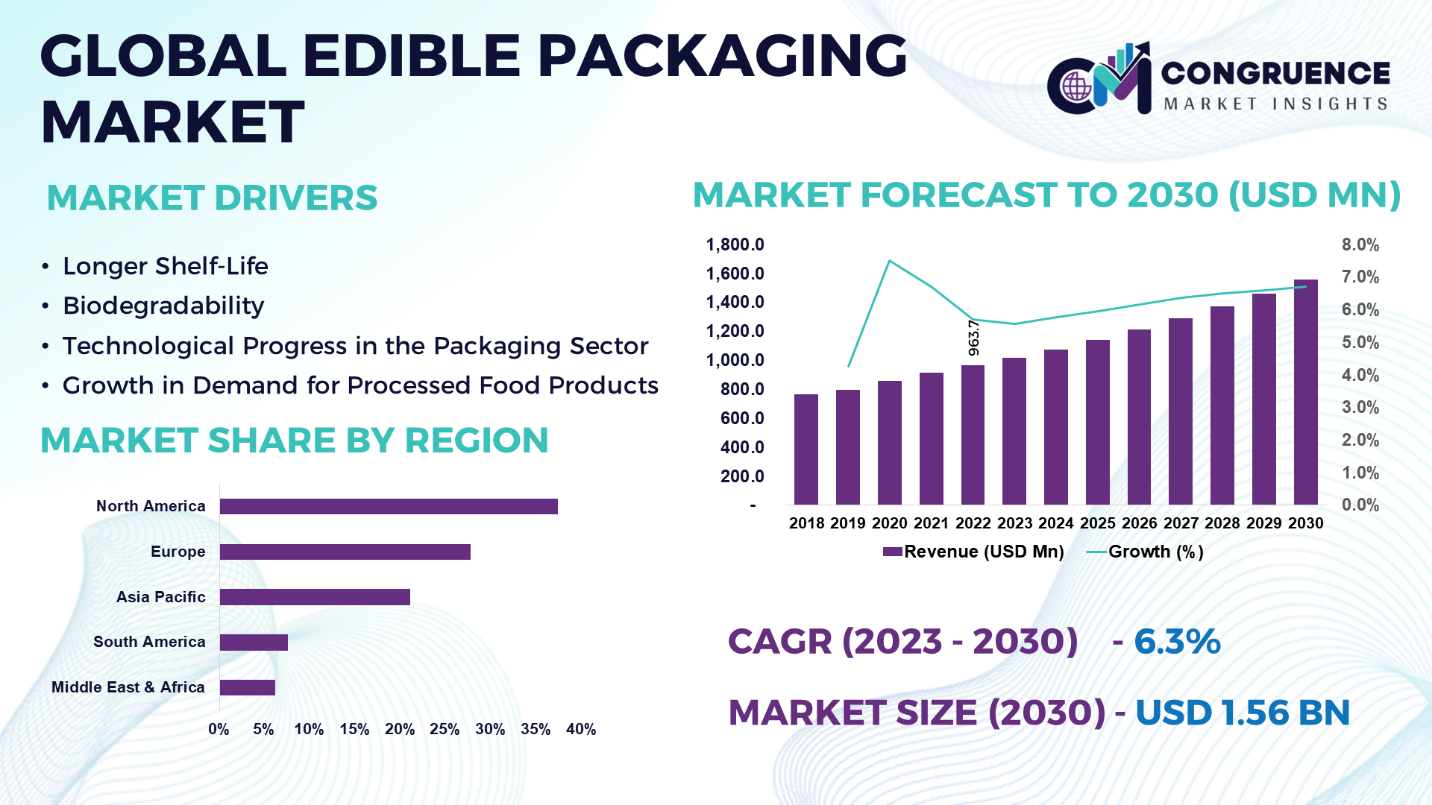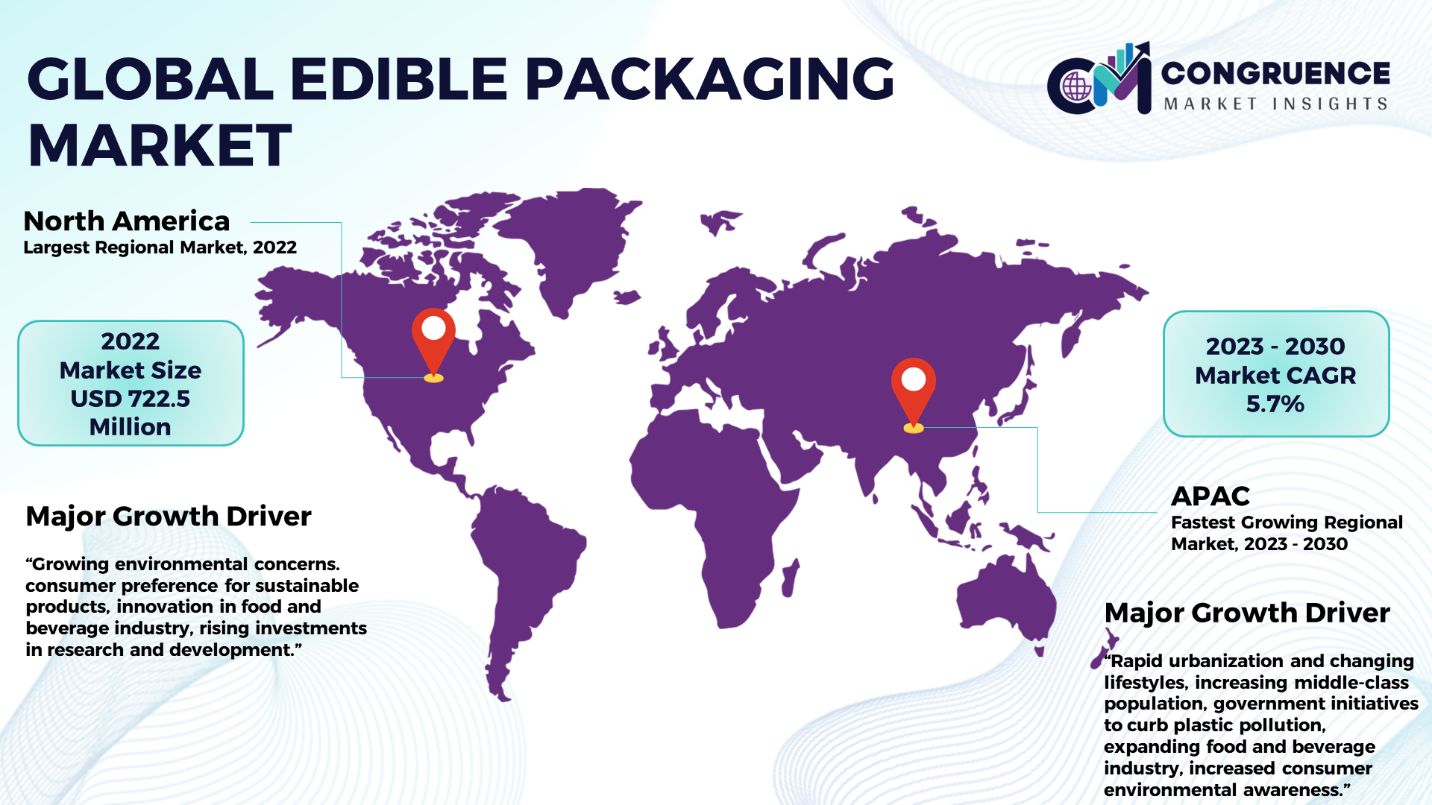Reports
The Global Edible Packaging Market was valued at USD 963.7 Million in 2022 and is anticipated to reach a value of USD 1,559 Million by 2030 expanding at a CAGR of 6.3% between 2023 and 2030.
Food-grade packaging, sometimes referred to as edible packaging, is typically composed of natural substances such as proteins, carbohydrates, or plant-based components. Its ability to withstand moisture helps prolong the lifespan of food by shielding it from the elements. It adds to a greener packaging solution and minimizes the trash produced by plastic. It can be employed for encasing liquid items including juice or alcohol and is frequently employed in single servings of snacks such as chips and candy. All of the organic, biodegradable components used to make edible packaging originate from vegetation. It is widely used to prevent solute, moisture, and air-related spoilage of food. Furthermore, it prolongs the lifespan of dietary goods, decreases trash, inhibits the growth of microorganisms and unintended chemical reactions. Unlike its alternatives, edible packaging doesn't need to be opened and thrown away in order to be consumed. It is becoming more and more appreciated worldwide as a result of its sustainability. The global edible packaging market is growing as a result of increased consumer demand for hygienic and long-lasting products, rising household income, and rising consumption of processed foods.

Edible Packaging Market Major Driving Forces
Longer Shelf-Life: Food products are becoming more and more popular due to consumer desire for processed foods that have been improved with sugar, fats, oils, and salt to improve flavor. In this expanding sector of the food business, the usage of edible coatings and films, which extend the shelf life of processed goods, is anticipated to foster industry expansion.
Biodegradability: The market is expected to increase significantly during the forecast period as a result of the growing demand for biodegradable films in edible packaging. The need for biodegradable films is rising. This lessened the need for fossil fuels and made it possible for materials including cellulose or starch-based polymers, polysaccharides, lipid, and composite films to offer novel characteristics and functionalities including biodegradability.
Technological Progress in the Packaging Sector: Although the industry for edible packaging is still in its infancy, some developments are being made. Food's nutritional value is increased by the application of nanotechnology technologies including multifunctional systems and nano encapsulation. In addition to shielding the food from heat and moisture, the edible coatings on active composites that are nanoencapsulated also keep other particles out of the meal.
Growth in Demand for Processed Food Products: Since processed foods have more sugar, fats, oils, and salts infused to improve their flavor and texture, there is a growing market demand for them. Edible coatings can help give the extended longevity of packaging that these processed goods demand. It is anticipated that the market for edible packaging would expand due to the adoption of edible films and coatings.
Edible Packaging Market Key Opportunities
Technological Developments: Technical developments in edible packaging, such as nanotechnology and the addition of nutritious proteins, are expected to drive market growth. The demand for edible packaging goods is expected to rise in countries such as China, Indonesia, and India. The development of infrastructure for plant-based raw materials and new government regulations are also expected to support market expansion. Concerns about disposable plastics and waste management have led to increased demand for sustainable resources and alternative natural resources for edible packaging production.
Online Retail and E-commerce Growth: The proliferation of e-commerce and online retail platforms presents a prospect for makers of edible packaging to broaden their market penetration and enhance their brand awareness. Global market expansion and product accessibility are made simpler by online sales platforms.
Customization and Personalization:
Consumers increasingly seek personalized and unique packaging solutions. Edible packaging manufacturers can offer customization options, allowing customers to choose materials, sizes, and designs tailored to their preferences. This trend enhances customer engagement and brand loyalty, creating opportunities for premium and niche markets.
Edible Packaging Market Key Trends
· Adoption of antimicrobial and antibacterial edible packaging treatments to enhance hygiene and cleanliness
· Sustainable packaging and shipping solutions to reduce the environmental impact of edible packaging distribution.
· Increased use of AI and data analytics for personalized edible packaging recommendations based on individual sleep patterns and preferences
· Customized and personalized edible packaging is becoming a trend, allowing consumers to choose packaging material in accordance to their will.
Region-wise Market Insights
North America accounted for the largest market share at 37.4% in 2022 whereas, Asia Pacific is expected to register the fastest growth, expanding at a CAGR of 7.1% between 2023 and 2030.

The largest share of the global market is held by North America, dominating 37.4% of market share, accounting USD 360.4 million. Its large processed food and pharmaceutical industries, together with a large number of edible packaging manufacturers, are responsible for its leading position in the global market. Additionally, the market is anticipated to be propelled by growing innovation in the edible packaging space during the course of the forecast period, particularly in the US. It is projected that the Asia Pacific market would grow at the quickest rate of CAGR 7.1%. The primary factors contributing to the product's extraordinary demand in the area are growing consumer awareness of the drawbacks of excessive plastic use in food packaging and the expansion of plastics bans. Rising sales in the food and beverage and pharmaceutical industries are also expected to drive up demand for products during the coming years. But it's expected that high manufacturing costs and unsanitary product transportation issues might prevent the industry from growing in the region.
Market Competition Landscape
To create novel materials, formulas, and technologies, edible packaging firms are making significant investments in research and development. They prioritize assuring safety and adhering to legal requirements while enhancing the edible packaging's flavor, texture, and functional aspects. Furthermore, they are offering companies the ability to directly print their logos, messaging, or branding on edible packaging through customization possibilities. In addition, a lot of businesses are working with restaurants, beverage firms, and food producers to include their goods into the packaging that already exists. These collaborations encourage the use of edible packaging in a variety of industries. In addition, they actively participate in educational efforts aimed at educating the public and companies about the advantages of edible packaging.
Key players in the global edible packaging market implement various organic and inorganic strategies to strengthen and improve their market positioning. Prominent players in the market include:
· WikiFoods, Inc.
· Notpla
· Evoware
· Loliware
· Apeel Sciences
· MonoSol (Kuraray Company)
· Tate & Lyle
· Tipa Corporation
· Devro
· Do Eat
· Lactips
· SoluBlue
· MonoPoly
· Safetraces
· AKAY Group
|
Report Attribute/Metric |
Details |
|
Market Revenue in 2022 |
USD 963.7 Million |
|
Market Revenue in 2030 |
USD 1,559 Million |
|
CAGR (2023 – 2030) |
6.3% |
|
Base Year |
2022 |
|
Forecast Period |
2023 – 2030 |
|
Historical Data |
2018 to 2022 |
|
Forecast Unit |
Value (US$ Mn) |
|
Key Report Deliverable |
Revenue Forecast, Growth Trends, Market Dynamics, Segmental Overview, Regional and Country-wise Analysis, Competition Landscape |
|
Segments Covered |
· By Source (Plant, Animal) · By Raw Material (Seaweeds & Algae, Polysaccharides, Lipids) · By Packaging Process (Antimicrobial, Nanotechnology, Electro hydrodynamic, Coatings, Microorganisms) · By End User (Food & Beverages, Pharmaceuticals) |
|
Geographies Covered |
North America: U.S., Canada and Mexico Europe: Germany, France, U.K., Italy, Spain, and Rest of Europe Asia Pacific: China, India, Japan, South Korea, Southeast Asia, and Rest of Asia Pacific South America: Brazil, Argentina, and Rest of Latin America Middle East & Africa: GCC Countries, South Africa, and Rest of Middle East & Africa |
|
Key Players Analyzed |
WikiFoods, Inc., Notpla, Evoware, Loliware, Apeel Sciences, MonoSol (Kuraray Company), Tate & Lyle, Tipa Corporation, Devro, Do Eat, Lactips, SoluBlue, MonoPoly, Safetraces, AKAY Group. |
|
Customization & Pricing |
Available on Request (10% Customization is Free) |
